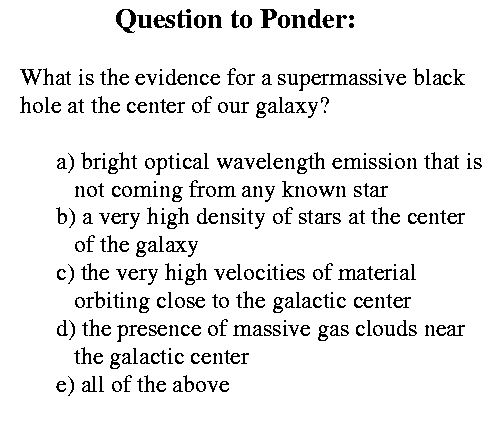|
No competent thinker, with the whole of the available evidence before
him, can now, it is safe to say, maintain any single nebula to be a
star system of coordinate rank with the Milky Way.Agnes Clerke, The System of Stars (1890) |
Assignments:Read Chapter 25, Section 4, pp. 404-408Problem Set #6 due Thursday, 1 April, 5:00pm
|

In Class:
pretty much finished up with our survey of our galaxy
- size, shape, location of center
- mass, dark matter problem
- spiral arms, star formation
- galactic center
Now it's time to move on to still larger scales in our universe
- until the 1920's it was thought that the GAX was everything
- i.e., everything on the universe was contained in the Gax
- actually Harlow Shapley was a champion of this point of
view, mainly because he found that our gax was large
- the issue was one of the spiral nebulae
- are the part of the GAX or not?
- if they're part of the gax, they're nearby and probably
clusters of stars or something
- if they're not part of the Gax, then they're really far away
and are "island universes," or copies of our own galaxy
- in that case, our galaxy is one a many in the
universe, and the universe must be a really large
place compared to our galaxy's size.
ie., MAJOR scale change
So it all boils down to figuring out how far away the spiral nebulae are
Distance measurement again
- this time parallax won't save us
- parallax works out to about 100pc or so
- HIPPARCOS gets us maybe to 500 pc
- Shapley told us the Gax is 30,000 pc across
- even if spiral nebulae are in the Gax, we
probably won't be able to measure their parallaxes
- more importantly, lack of parallax motion
won't settle the issue
So we need indirect methods to settle the debate
- evidence favoring a local solution
- distribution on the sky
- spiral nebulae are preferentially found perpendicular
to the plane
- "zone of avoidance"
- you might think that would argue that they're
_not_ part of the gax, but actually,
it's the opposite
- if they are completely independant of the GAX,
they should be distributed uniformly in the sky
- is, position of Gax wouldn't matter
- the fact that the distribution of spiral neb
bears some relation to the Gax argues that they
are associated
(what they didn't know about was dust, which obscures our
view through and beyond the Gax in the direction of the
plane)
- confusion between reflection nebulae and spiral nebulae
- reflection neb _are_ in the Gax
- they are gas surrounding one
(or a few) star(s)
- they are necessarily local
- one star, only so bright
- can't be too far away
- astronomers love to categorize and group
- want to associate properties of one source
to the entire group
- more often than not, a good idea
- not this time
- S Andromedae in 1885
- Andromeda neb was the largest of the spiral nebs
- presumably the nearest
- one star becomes one tenth as bright as the whole neb
--> neb can't possibly be as big as MW with all of
its millions of stars
-- must be local
- evidence favoring an external solution
- spectroscopy of spiral nebs
- composition different from galactic reflection nebs
- more like stellar spectra
- instead of gas (i.e., emission line) spectra
- doppler recession velocities are huge
- some measured at >1000 km/s
--> way too fast to be gravitationally bound
to the Gax
- rotation velocities (only a few)
- high rotation speeds
- need lots of mass, gax-sized mass
Well-matched positions
Curtis-Shapley debate 1922
no clear victor, through the high velocities of the spirals
was hard for the "one galaxy" proponents to explain
|
![]()